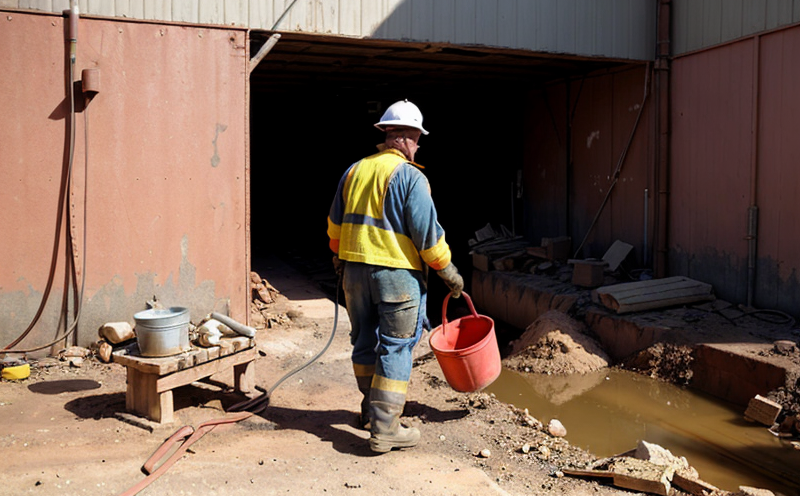EN 397 Industrial Safety Helmet Testing in Mines
The EN 397 standard specifically addresses industrial safety helmets designed to protect workers from head injuries. In mining environments, where hard-hat requirements are stringent due to the high risk of falling objects and mechanical hazards, this testing is critical for ensuring worker safety.
When selecting an industrial safety helmet for mine use, it's essential to meet or exceed EN 397 standards. This test evaluates a helmet’s ability to withstand various impacts from different directions, simulating real-world scenarios in mining operations. The testing process is rigorous and involves multiple stages:
- Impact absorption tests
- Penetration resistance tests
- Brightness retention tests (to ensure visibility)
- Comfort and fit tests to enhance usability
The helmet undergoes dynamic testing, where it is subjected to controlled impacts from a drop tower or pendulum. The results are compared against the standard's requirements for energy absorption, penetration resistance, and other critical parameters.
In addition to physical tests, environmental factors such as temperature and humidity can affect performance. Therefore, these conditions must be carefully controlled during testing to ensure accurate results that reflect real-world use.
EN 397 helmets are required in mines where there is a significant risk of head injuries from falling objects or mechanical hazards. For instance, in underground mining operations, the risk of head injury is particularly high due to the confined spaces and potential for heavy machinery operation. Compliance with EN 397 ensures that workers have the necessary protection against these risks.
The testing process not only protects individual miners but also contributes to overall mine safety by reducing the likelihood of serious injuries or fatalities. By ensuring that all helmets meet stringent standards, mines can improve their safety culture and reduce incidents.
| Test Type | Description | Expected Outcome |
|---|---|---|
| Impact Absorption Test | The helmet is dropped from a specified height onto an anvil. The absorption of impact energy by the helmet is measured. | The helmet should absorb at least 40% of the impact energy to pass this test. |
| Penetration Resistance Test | A steel hammer strikes the helmet from a specified height, attempting to penetrate it. The integrity of the shell must remain intact. | The helmet must not be penetrated by the hammer to pass. |
| Brightness Retention Test | The brightness and colorfastness of the helmet’s reflective surface are tested under various lighting conditions. | The reflective properties should maintain a minimum level over time. |
| Comfort and Fit Test | The helmet is adjusted to fit different head sizes, and comfort is assessed through subjective evaluation by test subjects. | The helmet must provide adequate comfort for most users without causing discomfort. |
Meeting the EN 397 standard ensures that miners have helmets that can effectively protect them from potential hazards. This testing process is essential in maintaining high standards of occupational health and safety, contributing to a safer work environment.
International Acceptance and Recognition
The EN 397 industrial safety helmet standard is widely recognized across Europe and beyond for its comprehensive approach to head protection. Many countries have adopted or referenced this standard in their national regulations, ensuring that workers across industries benefit from consistent safety practices.
In the mining sector, compliance with EN 397 is crucial as it directly impacts worker safety. Mines that adopt and implement these standards are demonstrating a commitment to occupational health and safety, which can enhance overall productivity and reduce insurance costs. Compliance also ensures that mines meet industry best practices and regulatory requirements in countries where they operate.
The international acceptance of EN 397 extends beyond Europe, with numerous mining companies around the world adopting this standard as part of their global safety protocols. This uniformity in safety standards helps to streamline operations across different regions, making it easier for mines to integrate into local markets and comply with local regulations.
Environmental and Sustainability Contributions
- Resource Efficiency: EN 397 helmets are designed to be durable, ensuring they last longer in harsh mining environments. This reduces the frequency of replacements, thereby minimizing resource consumption and waste generation.
- Eco-Friendly Materials: Many modern helmets made to this standard incorporate recycled materials or those with lower environmental impact, reducing the carbon footprint associated with their production.
- Disposal: Compliance with EN 397 ensures that helmets are robust and can be reused or recycled at the end of their lifecycle, promoting a circular economy in mining operations.
The use of such helmets supports sustainable practices by minimizing waste generation and resource consumption. By adopting these standards, mines contribute to environmental conservation efforts and demonstrate leadership in sustainable development.
Use Cases and Application Examples
- Underground Mining: In mines where the risk of head injury is high due to falling rocks or machinery, EN 397 helmets are essential. They provide a reliable barrier against potential impacts.
- Mining Equipment Operators: Operators of heavy equipment in mining environments must wear helmets that meet these standards to protect them from flying debris and other hazards.
- Support Staff: Non-operational staff, including maintenance personnel, must also comply with EN 397 to ensure they are protected while performing their duties within the mine.
| Use Case | Description | Outcome |
|---|---|---|
| Underground Mining | Helmets protect workers from falling rocks and machinery. | Reduces the risk of head injuries significantly. |
| Mining Equipment Operators | Operators wear helmets to safeguard against flying debris. | Avoids severe injuries during equipment operation. |
| Support Staff | Staff wear helmets for additional protection in the mine environment. | Enhances overall safety and reduces liability risks. |
The use of EN 397 helmets in mining operations exemplifies a proactive approach to occupational health and safety. By implementing these standards, mines can create safer working conditions for their employees, leading to better productivity and reduced healthcare costs.





